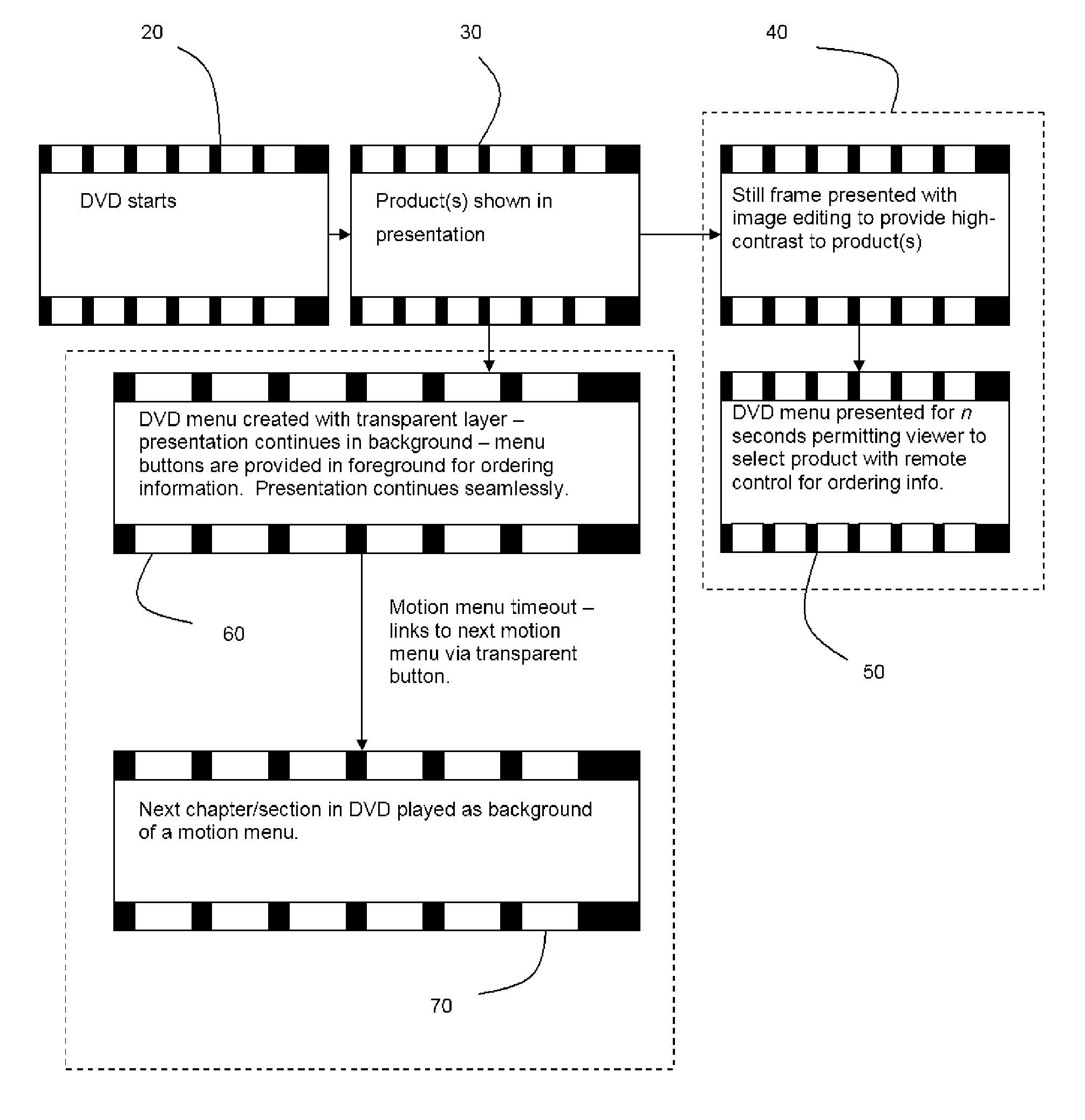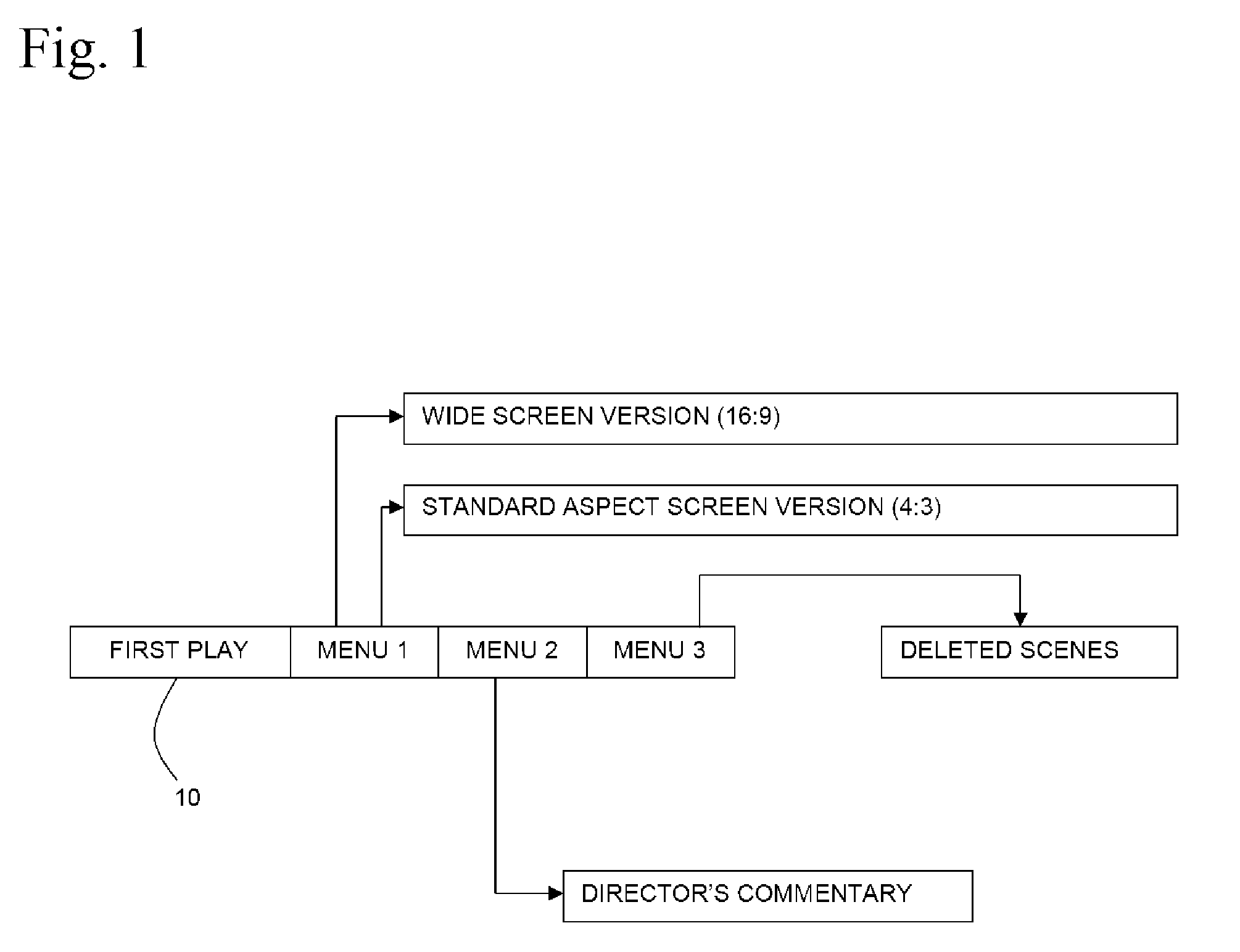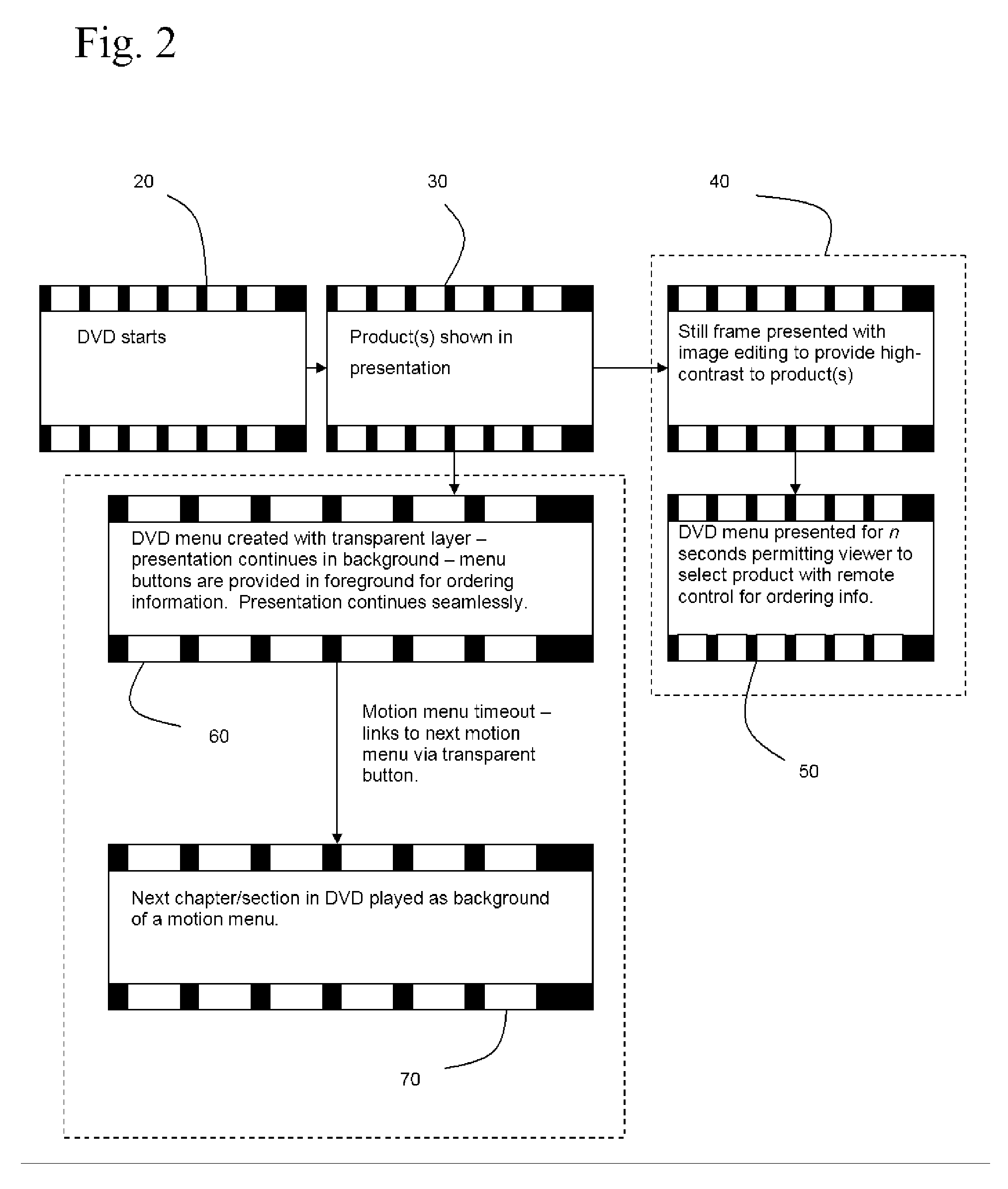[0007] The present invention is a method of advertising products utilizing the standard DVD ISO incorporated by virtually all home DVD players. The method can be generally summarized as presenting
purchasing information within a DVD having video content such as movies, documentaries, music videos, and the like. A product sought to be sold is identified within the video content. At least one frame of the video content showing the product is captured. The frame is modified to enhance the presence of the product. The product may be emphasized in a number of ways including gray-scaling the background of the frame, leaving the product in color; blurring the background, deleting the background or
solid-filling the background while leaving the product itself unmodified. An
advantage of emphasizing the product in the frame is that the context in which the product appears in the movie is noted to the viewer. Another
advantage of modifying the
single frame is that chroma effects are not required during production. Rather, post-production editors using off-the-shelf tools such as
ADOBE PHOTOSHOP may generate the effect. Yet another
advantage of modifying the
single frame is that the product itself may form a user-selectable button. For example, the rectangular area in which the product appears is copied, excluding the background. The rectangular area is then precisely overlayed over another image of the background so it appears as a
single image. However, when the viewer movies the menu selection over the product, it is selectable with visual response over that rectangular area defined by the product. In this manner, multiple products that appear in a
single frame may become user selectable in an aesthetically pleasing manner.
[0011] The invention embodied in a
computer software application for authoring video menu structures on a DVD includes a product
database module stored on a computer accessible medium, the product
database module including at least a
product identification data field and a time code
data field. The
database module may connect to a local or remote
data source. For enterprise-wide authoring, MICROSOFT
SQL,
ORACLE9i, IBM DB2 or similar product offerings may store the data in tables. A menu generation module communicatively coupled to the product database module generates a menu structure responsive to the presence of data fields in the product database module whereby product information contained within a submenu is user-accessible substantially contemporaneous to a product's appearance in the video content. While it is possible to generate a separate motion menu for each product that appears, this method might not be preferred. Fragmenting the video content into numerous motion menus may result in short pauses during which the disc seeks the next menu content. To viewers, the presentation will appear to stutter. Rather, a preferred embodiment of the invention calls for a grouping module communicatively coupled to the menu generation module whereby products that appear between predetermined time code values are grouped into at least one submenu. This permits a single motion menu to span a greater length of time whereby the
perception by the viewer is that the presentation is seamless and fluid.
[0016] Particularly in a feature films, there may be hundreds of brand name products or services clearly visible throughout the various scenes. In an embodiment of the invention, a remote
client interface is provided. The interface receives product and time code data which is communicatively coupled to the product database module. The remote
client interface is preferably a
platform independent device such as a
web browser to permit remote entry of product and time code data. The remote
client interface may permit upload of product information including
graphics and video. Preferably, the
graphics are compliant with the dimensions and resolutions commonly used in the discs (i.e., 720 by 480 pixels and 72 dpi). In addition, the video is preferably MPEG-2. A
server-side process may be employed to validate the compatibility of the uploaded files and reject those that do not meet the appropriate standards. Within the remote client interface, the video content may also be presented to assist the
end user in finding the correct time code. The time code data may be overlaid directly onto the video content displayed through the remote client interface. In addition, a preferred embodiment of the interface may split the video content into distinct chapters prior to viewing. This would alleviate
bandwidth limitation issues and permit an end user to work with one chapter while downloading another over a remote
data connection. Video content delivered to the remote client interface may be heavily watermarked to discourage pirating and recreational viewing.
[0017] The present invention may be utilized to generate pre-production revenue for video content such as major motion pictures, documentaries, music videos, sports programs and the like. Advertisers and sponsors take a more active role prior to the
initiation of the project rather than concurrently with production and / or post-production. An advantage of formulating the boundaries of product use at the pre-production stage is that the creative director and sponsor can determine, prior to footage being shot, the framework in which products may appear in the video content. This permits the creative director to maintain his or her artistic freedom while assuring the product advertiser that its objectives will be met as well.
[0021] The present invention also discloses a method of distributing DVDs having variable advertising content. The process includes establishing an array of
demographic data on an individual viewer, receiving a request for a video title from the viewer, automatically inserting advertising content targeted to the
demographic data of the viewer, recording the video title and
targeted advertising content on a DVD and distributing the disc to the viewer. The advertising content recorded on the disc and delivered to the viewer is recorded on a storage means so that advertising content previously distributed to the viewer is excluded in the next disc delivery. An advantage of this method is that video content that was created years ago, or even recorded onto disc years ago may be delivered with timely and
targeted advertising content. The advertising content may include services and products, including, but not limited to, theatrical trailers for additional motion picture productions.
 Login to View More
Login to View More  Login to View More
Login to View More 


